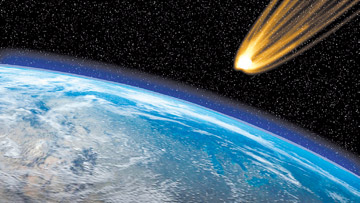Did giant impact from space wipe out animals?
About 13,000 years ago, the megafauna of North America began to die
out, and the world entered a brief cold period known as the Younger
Dryas.
But what drove the giant beasts into extinction? A controversial new
theory claims a giant space impact was the culprit.
 Between
this and the Solutrean hypothesis,it was apparently the week for
controversial hypotheses on North American prehistory. The Younger Dryas
impact hypothesis has been around since around 2007, and it might
actually be the subject of even fiercer dispute than the Solutrean
model, considering its proponents and its detractors canít even agree on
whether the supposed evidence to support it even exists. Between
this and the Solutrean hypothesis,it was apparently the week for
controversial hypotheses on North American prehistory. The Younger Dryas
impact hypothesis has been around since around 2007, and it might
actually be the subject of even fiercer dispute than the Solutrean
model, considering its proponents and its detractors canít even agree on
whether the supposed evidence to support it even exists.
Hereís what the model states, at least in one of the more popular
versions. About 12,900 years ago, an unusual type of impact occurred,
most likely a rare swarm of either comets or an unusual type of stony
meteorite known as carbonaceous chondrites.
Another possibility is an air burst similar to what exploded above
Tunguska in 1908, though several orders of magnitude greater.
Either way, this would have hit somewhere in North America, most
likely in the glaciers north of the Great Lakes, and the combination of
the devastation from the initial blast and resulting, continent-wide
wildfires would have wiped out most of the continentís megafauna and
likely much of its human population.
Itís a dramatic idea, but it has its problems. For one thing, thereís
no evidence in a population decline in humans at around that time, and
if anything even less evidence for those colossal wildfires. Whatís
more, while megafauna did go extinct around that time, they didnít all
die out at exactly that time, which rather defeats the point of
presupposing an impact that should kill them all in one fell swoop.
Thereís also the question of why only certain species went extinct -
even if youíre willing to grant that megafauna were just generally more
likely to go extinct than their smaller counterparts, why would large
species like bison and grizzly bears have survived, where giant sloths
and dire wolves didnít? And thereís still the question of how isolated
populations of mammoths and ground sloths survived for several thousand
years after this supposed extinction event.
Alternative hypothesis
So yes, this is very much an alternative hypothesis - bordering on
fringe, and if there is any truth to it, itís likely not as
straightforward as the current version of the model suggests.
And now, an international team of researchers have come up with the
latest possible piece of evidence to keep the Younger Dryas impact
hypothesis alive, at least for a little bit longer.
Specifically, they say they have located a thin layer of dark
sediment dating back to about 13,000 years ago. The layer contains items
like nanodiamonds and impact spherules that, according to the
researchers, are best explained by a cosmic body striking the earth and
scattering debris over a wide area.
They found evidence of a particular type of nanodiamond known as
lonsdaleite, which is only found in cosmic impacts.
The spherules also showed evidence of high velocity collisions that
likely make their origins extraterrestrial.
This particular evidence points to a large asteroid or comet fragment
entering the atmosphere, likely at a shallow angle.
The researchers say this rock, probably several hundred metres in
diameter, struck Earth and in turn melted rock, burned biomass, and
generally threw the environment into upheaval.
Its impact was likely principally felt in North and Central America,
though the researchers say this ties into evidence of similar sediments
found elsewhere in South America, Greenland, and Western Europe - the
same evidence that the modelís opponents have dismissed as, well, not
really there. |

